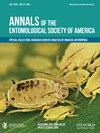线粒体DNA作为昆虫生态学分子标记的研究现状与展望
IF 3
3区 农林科学
Q1 ENTOMOLOGY
引用次数: 25
摘要
摘要分子技术是解决昆虫生态学中许多研究问题的有力工具。线粒体DNA(mtDNA)是一种应用广泛的分子标记。它易于使用,具有良好的生物学特性,如接近中性、缺乏重组和类似时钟的进化速率。然而,在使用mtDNA数据进行种群遗传学、物种划界以及估计种群和物种的进化史时,也存在一些问题。线粒体遗传的简单性和其他局限性的例外包括有效种群规模小、母体遗传和复杂的进化过程。结合mtDNA和核DNA标记可以提高分子数据测试系统发育和系统地理学假设的能力。我们综述了线粒体DNA在昆虫生态学中的应用,并得出结论,更好地了解线粒体的特性对于线粒体DNA的应用至关重要。本文章由计算机程序翻译,如有差异,请以英文原文为准。
Mitochondrial DNA as a Molecular Marker in Insect Ecology: Current Status and Future Prospects
Abstract Molecular techniques are powerful tools that can address many research problems in insect ecology. Mitochondrial DNA (mtDNA) is a widely used molecular marker. It is easy to use and has favorable biological properties, such as near-neutrality, lack of recombination, and a clock-like evolutionary rate. However, there are some issues involved when using mtDNA data in population genetics, species delimitation, and estimating the evolutionary history of populations and species. Exceptions to the simplicity of mitochondrial inheritance and other limitations include small effective population sizes, maternal inheritance, and complex evolutionary processes. Combining mtDNA and nuclear DNA markers can improve the power of molecular data to test phylogenetic and phylogeographic hypotheses. We review the applications of mtDNA in insect ecology and conclude that a better understanding of the properties of mitochondria is essential for the application of mtDNA.
求助全文
通过发布文献求助,成功后即可免费获取论文全文。
去求助
来源期刊
CiteScore
4.90
自引率
0.00%
发文量
25
审稿时长
6-12 weeks
期刊介绍:
The Annals of the Entomological Society of America exists to stimulate interdisciplinary dialogue across the entomological disciplines and to advance cooperative interaction among diverse groups of entomologists. It seeks to attract and publish cutting-edge research, reviews, collections of articles on a common topic of broad interest, and discussion of topics with national or international importance. We especially welcome articles covering developing areas of research, controversial issues or debate, and topics of importance to society. Manuscripts that are primarily reports of new species, methodology, pest management, or the biology of single species generally will be referred to other journals of the ESA. The most important criteria for acceptance are quality of work and breadth of interest to the readership.

 求助内容:
求助内容: 应助结果提醒方式:
应助结果提醒方式:


